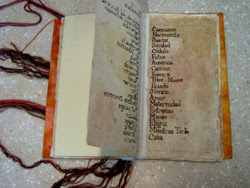
By: ANTONIO LÓPEZ GUZMÁN.
The elders in the early days there was a beautiful Bisíu be called, was all it can feel a being. He and we had the wonderful power of making sounds and talking. He was one of the first who spoke of the need for a party gifts. Therefore, a hint of the people, was to get some fruits called Sime, some fruit for party gifts. These fruits are given in the tree called sëmeinë or Seme, also currency call fifty, is a fruit that has lots of butter, and is a food that makes the progress of human instincts (eat barbecue).
Human beings, having eaten the fruit of fifty currency have felt its effect Bisíu learned, became his disciples went their living descendants who lived in a part of the earth. Other things you learned from Bisíu were: deer, tapirs and wild pigs, bear little resemblance lusty animals to humans. They all learned the knowledge that brought the fruit of the tree of similarity. The others were paired in the deep forest green.
Bisíu produced a sound like a deer, Dante and he bristles hill is why since he habla entonces Bisíu Language of fertile mountain, which is why the trumpet Yuruparí suena en la Actualidad giving those voices.
BISÍU
1. GSE Mamarógere bisíu aríyuhpe maria dohpáta aríyuhpe
2. Will Aripa dohpa bihsí yupë IGE bisíu
3. anger will merely Aripa mere name Kemeri YUHP, oa mere nyamaa
4. gamuyera nege Maharis arikoma anger.
5. GSE dahígë bisíu aríperera dohpa bihsí yupë.
6. igeta pooge Arigo Poori is YUHP
7. sëmegëge ige mere stop mahara meríanyora
8. iri seanyorá poori iROG paroríre Peam diúu mërinyorá
9. iri seme Peam diodóge yurinyahayoro anger, poásériro váyoro
10. ige ige dahíge bisíu paarúge obíatu nuguka yuhp
11. MASA Dahíge Beige dohpa váyuhpe
12. Dahir mahsápe gameúnyora bisíure ige ige paarúge obíatu do pere
BISÍU
1. From the beginning there Bisíu, he was like us.
2. Like all animals, had Bisíu sexual orientation.
3. Bisíu wanted the deer and all animals that mate.
4. The coupling sweet do forest animals.
5. Bisíu, friendly, did so sweetly.
6. Was Bisíu who collected the fruits of similarity to suggest to young people.
7. Friends climbed Bisíu (teens) in a tree of similarity.
8. They picked the fruit of the tree, and throwing.
9. A sheath with a mature pit was falling on the hearth, and produced an odor suggestive.
10. The smell nice fruit sweetness to sacrifice Bisíu impregnated.
11. Thus began the friendship of Bisíu with forest animals.
12. Bisíu was summoned again by the people who asked for more explanations because
apparent damage to the young was very large.










